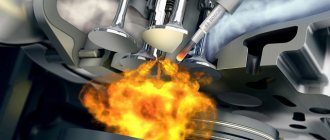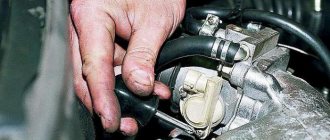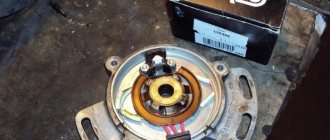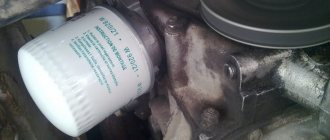For quite some time now, the difference in cost between gasoline and diesel fuel has ceased to be significant. Therefore, buying a diesel car does not provide the expected advantage.
Changes in the situation on the fuel market have led to the fact that not only owners of gasoline, but also diesel cars are thinking about switching to gas. If no special problems arise with gasoline internal combustion engines, then there are many more questions with diesel engines.
Motorists are interested in whether such a transition can be made, how it will turn out and how profitable it really is.
Features of the use of gas on diesel internal combustion engines
If you are thinking about converting your diesel engine to gas, and at the same time you have a passenger car, you should first study all the current features of such a solution.
The key difference between diesel and gasoline is the principle of fuel combustion in the chamber.
A gasoline engine uses a spark plug. It gives a spark and ignites the gas-air mixture. The situation with diesel and turbodiesel internal combustion engines is different. Here, the air is first strongly compressed under pressure, which allows its temperature to rise. At the last moment, the nozzle supplies diesel into the chamber. The heated and compressed mixture spontaneously ignites. But if you try to switch it to gas, the situation changes.
It is important to understand how gas fuel works. This means methane or propane-butane. If you supply gas to the cylinders, replacing diesel fuel with it, the mixture will not spontaneously ignite. A higher temperature is required for ignition.
To solve this problem, most of the diesel fuel is used, after which gas is supplied. When ignited, diesel fuel ignites the gas.
That is, a diesel engine can run on gas-cylinder equipment, but it is impossible to completely abandon diesel fuel. The two fuels will be used simultaneously, in certain proportions. Usually this is no more than 70-75% gas and up to 30% diesel. This is a good way to improve economic performance and reduce the cost of visiting a gas station.
There is an alternative option that uses only gas. But then you will have to completely dismantle the fuel compartment, use a third-party ignition device, modernize the cylinder head and carry out a number of additional measures as recommended. Difficult and expensive.
Operating principle of a gas-diesel engine
The switch to gas fuel is carried out using a switch from inside the car after warming up the engine, or automatically. The gas supply process is controlled by the electronic control unit of the gas treatment unit. Gas is supplied to the diesel engine in doses using injectors into the intake manifold. From where it mixes with air, on the intake stroke, it enters the cylinders through the intake valves. Then diesel fuel is sprayed into the gas-air mixture compressed by the piston (compression stroke), where an explosion occurs due to pressure and temperature. D/t here acts as a fuse, since the ignition temperature of the gas is higher than diesel fuel and it itself cannot ignite.
Types of fuel used
Conversion of a classic diesel engine to gas is possible only for a specific type of alternative fuel. You cannot use methane and propane-butane at the same time.
In terms of cost, switching from diesel fuel to methane will be more expensive than converting from diesel to propane-butane. But this way the best economic effect is achieved.
Methane will allow better fuel economy, although propane will cost less to install.
Switching to propane allows you to use gas for no more than 30-50% of the total volume of fuel burned. And the share of methane can be up to 80%. The following characteristics are taken into account:
- engine speed;
- period of the year;
- load on the fuel system;
- road terrain;
- pressure and temperature indicators of gas;
- presence or absence of a turbine.
Considering all this and the principle of operation when diesel turns to gas, we can conclude that methane plants will be more preferable.
How does HBO work?
Diesel fuel burns under pressure, but gas does not. The process will proceed as follows:
- The supply of diesel, which is responsible for ignition, is reduced.
- The gas injection process takes place.
Gas injectors will work simultaneously with diesel ones. Their ratio depends on the engine speed. Most often it is 50/50 for propane. If methane, the gas share increases to 70 percent and higher. If you're driving on the highway, gas usage will be highest.
What cars is it used on?
To the question of whether it is possible to convert regular diesel to gas, the answer will be in the affirmative. Such an alteration is indeed possible. But it is also important to consider for which car such an upgrade is planned.
In theory, any engine that runs on diesel fuel can be adapted for gas equipment. Moreover, the standard type of fuel system used does not play a key role.
Conventional atmospheric diesel internal combustion engines and turbocharged engines can be converted to gas diesel.
The costs of re-equipping a passenger car are naturally lower compared to modernizing a truck or special equipment. But if the machine travels short distances, then the payback period for the equipment can be several years. Therefore, conversions in which diesel also runs on gas mainly concern commercial vehicles.
What is needed to install gas equipment on diesel?
- Control block. The main thing in this system. It consists of controllers and controls the operation of the kit.
- Fuel pump One of the most important components. Needed to supply fuel. If you use gas, you will have to convert it.
- Reducer-evaporator. In cylinders, propane is in a liquid state. A reduction evaporator is needed to convert it into gas. Methane is already in a gaseous state, but a reducer is still needed to maintain pressure.
- Gas injectors. Necessary for supplying gas to the combustion chamber.
- Fuel switch. It is necessary that the driver can manually change the fuel at will.
- Temperature, synchronization, gas sensors and others. Needed for the engine. Used to create a mixture.
- Gas cylinder. Quite large size. That's where the gas is.
- Highway. This is the tube that carries gas from the cylinder to the engine.
- Refueling devices. Needed for gas refilling.
- Multivalve. This is necessary so that the gas can enter and exit the cylinder.
- Protective equipment. Necessary to protect the cylinder from overfilling and releasing excess pressure.
- Filter. Responsible for purifying gas from impurities and debris.
As you can see, diesel fuel gas has a lot of advantages. It is indispensable for trucks and large equipment.
Possibility of DIY installation
Many people ask questions about whether it is possible to independently supply gas to a diesel engine and switch the engine to an alternative fuel without outside intervention. In theory it is possible, but in practice everything is much more complicated.
If you ask whether it is actually possible to install LPG on a diesel engine, all experts will definitely answer in the affirmative. Such a transition is possible. The only problem is that it is impossible to do this yourself without special equipment and tools.
You can find out from the owners of gas-diesel cars themselves whether they put gas in a regular diesel engine in a garage. There are craftsmen who assemble the knot themselves. The biggest difficulties are usually associated with:
- connecting gas equipment;
- adaptation and synchronization of the standard fuel system;
- installation of electronics;
- installation of control and measuring instruments.
Yes, in theory, you can install gas in a diesel car yourself, but you will additionally have to find the appropriate software.
But there are several pitfalls in this situation. It was not for nothing that it was noted that it is possible to supply gas if you have a diesel engine, rather in theory, with your own hands. Whether this is true in practice is an extremely pressing question. The problem of self-installation is supported by the following nuances:
- Technically, it is very difficult to implement such a project on your own. You need equipment, tools, special software. This stops about 80% of attempts to do everything yourself.
- When switching to an alternative type of fuel, special documentary evidence is required that the work was performed by a licensed specialized service.
- Without such confirmation, another difficulty arises. This is registration of the alteration with the traffic police. And the absence of notes about changes is punishable by a fine.
In the absence of permission, the car owner will not only be fined, but also forced to dismantle the LPG.
This largely answers the question of whether LPG systems are installed on diesel monofuel engines and why it is better to entrust such work to specialists of the appropriate profile.
Tips and tricks
For high-quality implementation of the task, it is recommended to purchase LPG systems for diesel engines from trusted manufacturers (Westport, OMVL, etc.). It is important that installation kits are specifically designed and adapted for such installations, and are properly certified.
- It is worth approaching the choice of installers themselves with great responsibility. If you have decided to install gas equipment on a diesel engine, it is better to contact large installation centers that provide a guarantee both for the equipment (if you purchase gas equipment at a specific installation center) and for the work performed.
When choosing an installation kit, it is worth considering that today in the CIS one of the most profitable and economically feasible solutions is the installation of methane equipment on a diesel engine. The fact is that such an installation makes it possible to replace about 75-80% of diesel fuel with methane, while replacement with propane is only possible by 40-45%
- It is also highly advisable to pay attention to the latest developments and technologies, since installing LPG on a diesel engine is a more “delicate” process compared to its gasoline counterparts.
For example, HPDI technology is a relatively new scheme that allows for high-precision combined supply of diesel fuel and methane gas, while the ratio of diesel fuel replacement with gas reaches 95% gas to 5% diesel fuel.
The solution is based on a special nozzle that is capable of sequentially injecting gas and diesel fuel. In other words, one injector first supplies a small portion of diesel fuel into the cylinder, and only then the main injection of the methane charge occurs.
We also recommend reading the article about which injectors for HBO-4 are best to choose. From this article you will learn about the features of gas injectors, their main differences from gasoline and diesel injectors, as well as which option is better to choose in this or that case.
The previously supplied diesel fuel ignites naturally from compression, playing the role of a spark plug, and the main portion of gas is injected closer to the very end of the compression stroke and is ignited from the already burning diesel fuel. Such solutions allow you to operate a diesel internal combustion engine on gas with maximum savings.
- We also add that electronic engine control systems must be configured after installing LPG. To do this, unique software must be used that allows fine-tuning. As a result, the composition of the mixture in all modes will be optimal, which allows you to increase the resource of a gas-powered diesel engine, obtain the desired output from the engine, reduce the level of exhaust toxicity, etc.
Retrofitting methods
There are 2 main ways to install gas equipment on a diesel engine.
- Complete refurbishment of the internal combustion engine. This allows you to completely abandon diesel fuel. But drastic changes have to be made. Here you need to change the compression ratio, install an ignition system, etc. In total, this will cost at least 200 thousand rubles. At the same time, the engine’s power and torque ratings will drop.
- Application of the Dual Fuel system. This is a dual-fuel system in which diesel fuel and gas are used in certain proportions. Modernization costs up to 100 thousand rubles.
It is the second method that is most widespread.
HBO equipment
It has few differences when compared with gas equipment for gasoline engines. But on diesel engines it becomes possible to control the supply of diesel fuel using a special device.
For cars with different fuel supply systems, electronic activators or software units that control the system are suitable.
They allow you to shut off or open the gas system if necessary. Their advantages:
- Security system monitoring.
- Possibility of opening the gas supply if it runs out.
- The ability to force the car to use diesel by pressing just one button.
Advantages and disadvantages
Before installing gas equipment on diesel engines, you need to take an objective look at such conversion.
Let's start with the shortcomings. If a diesel engine runs on gas, this may entail the following negative aspects:
- Installing the system and re-equipping the internal combustion engine requires spending quite a lot of money. This is more expensive than a similar retrofit of a gasoline internal combustion engine.
- The costs of time and money for subsequent maintenance increase. Periodically you will have to carry out adjustments and adjustments. Repairing the system is expensive if serious malfunctions occur.
- To place additional cylinders you need to find a place. If it's the luggage compartment, a significant portion of the usable space in the car will disappear.
- The weight of the vehicle increases. But this can mainly affect passenger cars. But on trucks and special equipment, the presence of a gas system is not strongly felt by the driver.
- The need for mandatory registration of such alterations and changes to the vehicle documentation. And this procedure takes quite a lot of time.
- Lack of a large number of qualified specialists. There are not many craftsmen in the country capable of converting a car to gas from diesel. This increases the cost and may affect the final quality of the work.
But there are also positive aspects. Moreover, there are quite a lot of them, they are significant and can offset all the shortcomings.
The advantages of switching from diesel to gas-diesel include the following points.
- The efficiency of the engine increases, the overall life of the motor increases. At the same time, power and torque do not change. Under certain circumstances, performance can be improved by 5-25%.
- The service life of the fuel system increases. The resource can be increased by 1.5-2 times. If your car has a Common Rail system, switching to gas-diesel will have a positive effect on its service life.
- Indicators of harmful emissions fall, the smoke of the exhaust system in the car decreases.
- Engine operation becomes smoother. Positive changes in noise levels are observed.
- The amount of soot and deposits inside the combustion chamber and in the cylinders is reduced. The service life of the particulate filter is also extended due to less intense contamination.
- The costs of replacing and purchasing motor oil are falling. On a gas-diesel engine, the lubricant lasts longer than when working simply on diesel fuel.
- If you use a dual-fuel system, you can travel more kilometers without refueling.
- There is no need to make changes or alter the motor itself.
Whether to use such a system or not is everyone’s personal choice.
Feasibility of installation
As we know, diesel units are already quite economical, is it worth paying 80,000 to install Dual Fuel? What's the benefit?
There is a benefit, but not as big as with the gasoline option.
Let’s say that our diesel consumption is 10 liters per 100 km, if we take average prices it is 35 rubles per liter, that is, 350 rubles per 100 km, without gas.
Our gas cost is 16 rubles (we take propane), it will replace about 50% of liquid fuel. That is, it turns out (16 X 5 = 80 rubles) and (35 X 5 = 175 rubles) = 255 rubles, the difference is 95 rubles from 100 km, from 1000 - 950 rubles.
Of course, if you move around a lot, then of course it makes sense! However, for a private passenger car with a mileage of 1000 - 1500 km per month, the payback of the equipment will occur in 60 - 70 months, here, in my opinion, you need to think very hard.
Now we are watching the video version.
I’ll end here, I think my article was useful to you, sincerely your AUTOBLOGGER.
(
15 votes, average: 4.40 out of 5)
Similar news
Gas for cars: pros and cons. Let's look at propane and methane + video
Removes moisture (water) from the gas tank. With your own hands
Which gasoline burns faster, longer and better? 92 – 95 – 98 or 100.
Add a comment Cancel reply
Comments
TOP articles for the month
The holidays are coming, which means most of our country will be drinking alcohol. Easy: -…
I have many different articles and videos on various gearboxes, for example here...
The vehicle battery voltage, as well as its capacity, are the most important indicators of this automotive unit,...
Methane
Methane is a natural gas that is stored in deposits deep within the earth. It is used almost in its pure form, only slightly filtered. Methane has the highest safety among gases, and it is almost completely environmentally friendly. This gas cannot be spoiled or diluted in any way. Its composition always remains the same.
Filling a car with methane is 3 times cheaper than filling a car with gasoline, which is a big advantage of this type of gas. If we consider the environmental friendliness of methane, it has a special standard - Euro 5. This indicates its high environmental friendliness. Methane is considered a modern fuel and is loved by motorists in many European countries, as well as in the USA, because by using it you can reduce the amount of harmful emissions several times.











